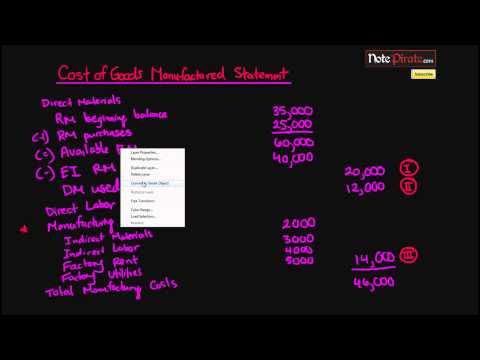1.6: The Statement of Cost of Goods Manufactured
- Page ID
- 65664
The statement of cost of goods manufactured supports the cost of goods sold figure on the income statement. The two most important numbers on this statement are the total manufacturing cost and the cost of goods manufactured. Be careful not to confuse the terms total manufacturing cost and cost of goods manufactured with each other or with the cost of goods sold.
Total Manufacturing Cost includes the costs of all resources put into production during the period (meaning, the direct materials, direct labor and overhead applied). Cost of goods manufactured consists of the cost of all goods completed during the period. It includes total manufacturing costs plus the beginning work in process inventory minus the ending work in process inventory. Cost of goods sold are the costs of all goods SOLD during the period and includes the cost of goods manufactured plus the beginning finished goods inventory minus the ending finished goods inventory. Cost of goods sold is reported as an expense on the income statements and is the only time product costs are expensed. This chart will summarize the formulas you will need:
| Direct Materials Used | Beginning Raw Materials Inventory + Raw Material Purchases – Ending Raw Materials Inventory – Indirect Materials Used |
| Total Manufacturing Cost | Direct Materials + Direct Labor + Overhead applied |
| Cost of Goods Manufactured | Total Manufacturing Cost (Direct Materials + Direct Labor + Overhead applied) + Beginning Work In Process Inventory – Ending Work in Process Inventory |
| Cost of Goods Sold | Beginning Finished Goods Inventory + Cost of Goods Manufactured – Ending Finished Goods Inventory |
NoteLook at the following example. Farside Manufacturing makes calendars and books. The schedule (or statement) of cost of goods manufactured follows:
| Farside Manufacturing Company | ||
| Statement of cost of goods manufactured | ||
| For the year ended December 31 | ||
| Direct Materials Used: | ||
| Raw Materials inventory, January 1 | $40,000 | |
| Raw Materials purchases | 480,000 | |
| Less: Raw Materials inventory, December 31 | 30,000 | |
| Raw Materials used | $490,000 | |
| Less: Indirect Materials Used | $0 | |
| Direct Materials Used | $490,000 | |
| Direct labor | 380,000 | |
| Manufacturing overhead: | ||
| Indirect labor | $120,000 | |
| Maintenance and repairs expense | 60,000 | |
| Factory utilities expense | 10,000 | |
| Depreciation expense – factory building | 20,000 | |
| Depreciation expense – factory equipment | 30,000 | |
| Other expense – factory | 20,000 | |
| Total manufacturing overhead | 260,000 | |
| Total Manufacturing Cost | $1,130,000 | |
| Add: Work in process inventory, January 1 | 30,000 | |
| Less: Work in process inventory, December 31 | -60,000 | |
| Cost of goods manufactured | $1,100,000 | |
Note how the statement shows the costs incurred for direct materials, direct labor, and manufacturing overhead. The statement totals these three costs for total manufacturing cost during the period. When adding beginning work in process inventory and deducting ending work in process inventory from the total manufacturing cost, we obtain cost of goods manufactured or completed. Cost of goods sold does not appear on the cost of goods manufactured statement but on the income statement.
To make the manufacturer’s income statement more understandable to readers of the financial statements, accountants do not show all of the details that appear in the cost of goods manufactured statement. Next, we show the income statement for Farside Manufacturing Company. Notice the relationship of the statement of cost of goods manufactured to the income statement.
The cost of goods manufactured appears in the cost of goods sold section of the income statement. The cost of goods manufactured is in the same place that purchases would be presented on a merchandiser’s income statement. We add cost of goods manufactured to beginning finished goods inventory to derive cost of goods available for sale. This is similar to the merchandiser who presents purchases added to beginning merchandise to derive goods available for sale.
| Farside Manufacturing Company | ||
| Income statement | ||
| For the year ended December 31 | ||
| Sales | $1,800,000 | |
| Cost of goods sold: | ||
| Finished goods inventory, January 1 | $50,000 | |
| Cost of goods manufactured | 1,100,000 | |
| Cost of goods available for sale | $1,150,000 | |
| Less: Finished goods inventory, December 31 | 60,000 | |
| Cost of goods sold | 1,090,000 | |
| Gross margin (Sales – Cost of goods sold) | $710,000 | |
| Operating expenses: | ||
| Selling expenses | $300,000 | |
| Administrative expenses | 200,000 | |
| Total operating expenses | 500,000 | |
| Income from operations | $210,000 | |
Note: Cost of goods available for sale represents all items completed and read to sell during the period. It is calculated as beginning finished goods inventory + cost of goods manufactured from the statement of cost of goods manufactured. Income from operations is calculated as Gross Margin (also called Gross Profit) – total operating expenses.
Contributors and Attributions
- Accounting Principles: A Business Perspective.. Authored by: James Don Edwards, University of Georgia & Roger H. Hermanson, Georgia State University.. Provided by: Endeavour International Corporation. Project: The Global Text Project.. License: CC BY: Attribution
- How to Prepare a Cost of Goods Manufactured Statement (Managerial Accounting Tutorial #24) . Authored by: Note Pirate. Located at: https://youtu.be/Ycezt5Hu06M. License: CC BY: Attribution


